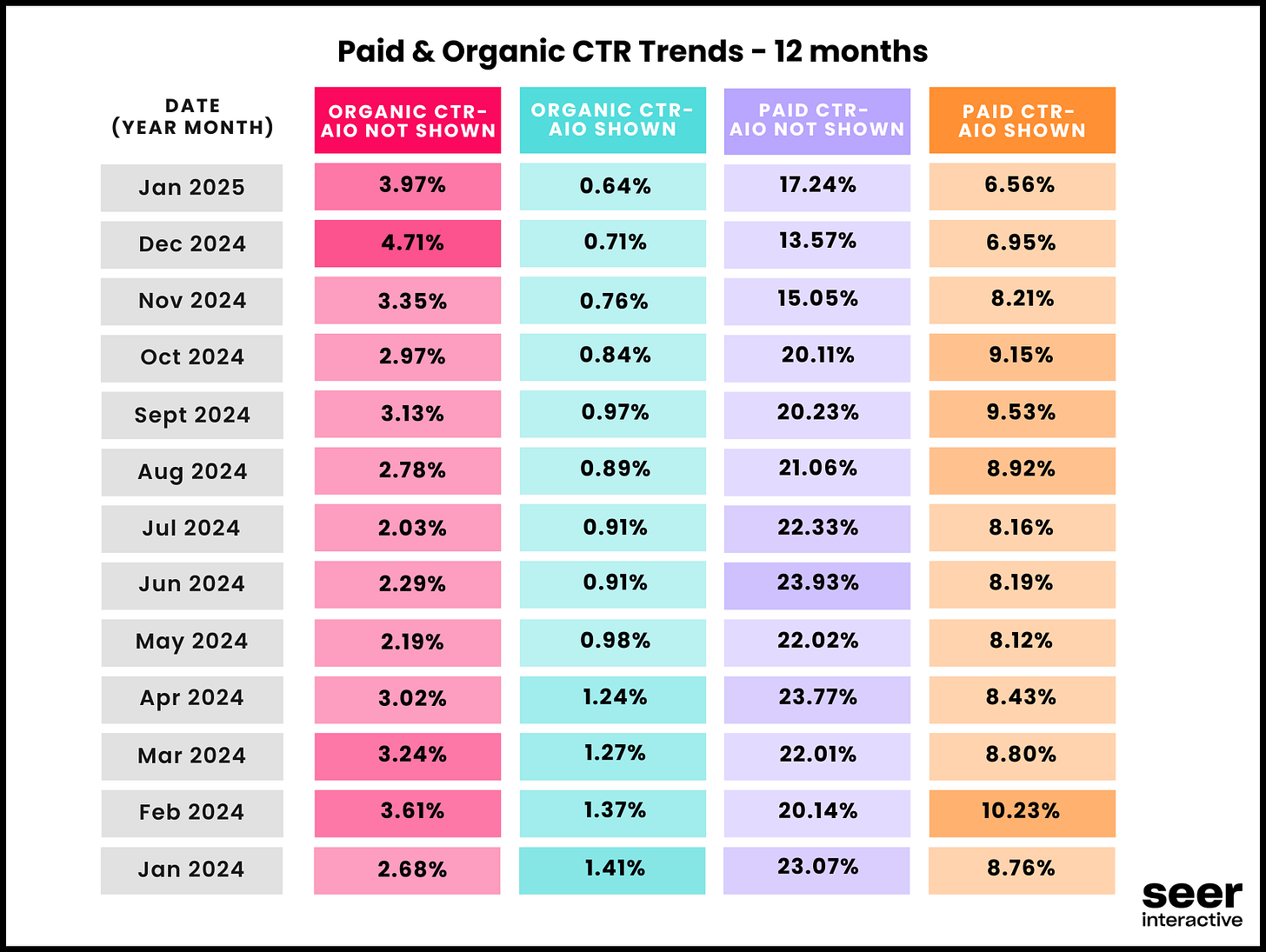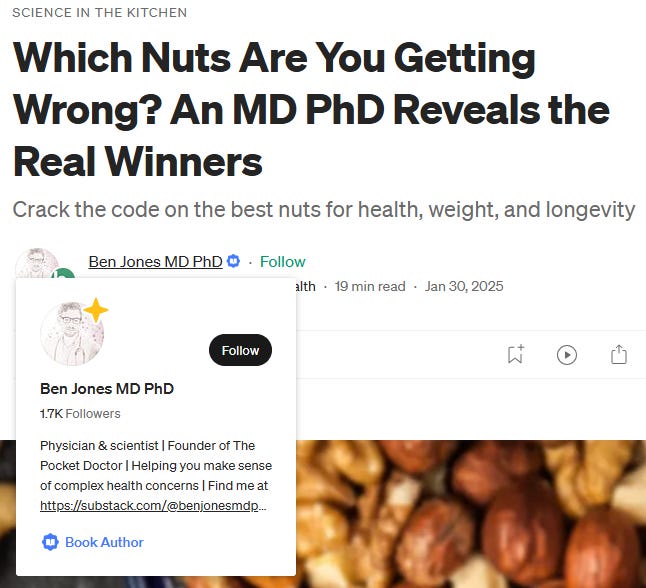AI Overviews are Killing CTR, A Warning on SEO Filler Text & Using Search Console & Google Analytics for SEO Insights
SEO TL;DR #58 10/02/2025
I’m back after a week-long trip to Disney, with my adrenaline metre high and my funds low (thanks, Walt). It also means catching up on all the latest SEO news, which is what you’re all here for, so without further ado…
AI X SEO
Google’s AI Overviews Are Killing Click-Through Rates
Google’s AI Overviews (AIOs) are eating into both organic and paid search click-through rates (CTR), but the extent of the impact depends on the query type. A study by Seer Interactive analysed over 10,000 keywords and found:
Organic CTR is sinking for AIO queries – dropping from 1.41% to 0.64% year-over-year.
Non-AIO queries are holding strong – organic CTR actually increased for these searches.
Paid CTR is down across the board – whether AIOs are present or not, users seem to be clicking fewer ads.
Owning the AIO spot boosts CTR – when a brand appears in AIOs, both organic and paid CTRs see a lift.
💡 Takeaway: AIOs are reshaping search behaviour, and SEO strategies must adapt.
Analyse your queries – Identify which of your keywords are most at risk of AIO impact. Queries that previously triggered featured snippets are likely the most vulnerable.
Optimise for AIOs – If AI Overviews are pulling answers from your competitors, work on structured data, authority-building, and content formatting to increase your chances of being included.
Target non-AIO searches – Since organic CTR is rising for queries without AIOs, these may offer stronger traffic opportunities.
Reassess paid search strategy – With paid CTR dropping across the board, test new ad formats, adjust bidding, and consider diversifying your marketing mix beyond Google.
Break down silos – If you do not appear in AIOs, align your SEO, PR, and paid teams to push for inclusion through brand visibility efforts.
AIOs aren’t going anywhere, so tracking their impact and adjusting your strategy will be key to maintaining search visibility.
Content SEO
Google Calls Out SEO-First Author Bios
John Mueller has weighed in on the use of author bios for SEO, making it clear that Google (and users) can spot when they’re written purely for ranking purposes.
Responding to a post by Nikki Pilkington on Bluesky, he called out bios that feel unnatural, saying, “It’s kinda awkward, not reassuring.”.
💡 Takeaway: Focus on writing genuine, useful bios that showcase expertise and credibility naturally. Well-written, authentic author pages can still support E-E-A-T, but forcing it won’t fool Google - or your audience.
I personally like the way Medium uses mini-author profiles when you hover over the name, which, when clicked, goes to the author’s full profile page.
The necessity of Author profiles is hugely dependent on the topic, too; if it’s health-related, I want to see some official accreditations there, but if it’s something less serious, I’m more interested in the author's personality (which you can also showcase in a bio).
Content SEO
Google Warns Recipe Sites About Excessive Scrolling
Google’s latest Quality Rater Guidelines update takes aim at recipe sites that force users to scroll excessively or bury the “jump to recipe” button. A new section in the guidelines labels these practices as low quality because they create a frustrating user experience.
The update highlights:
Recipes buried under excessive content (like personal stories, unrelated reviews, or excessive ads) can be classed as low quality.
Difficult-to-find “jump to recipe” buttons also contribute to a poor rating.
Cleaner layouts and easy access to the actual recipe could improve rankings.
Similarly last week, John Mueller called out how SEOs can spot over-optimised content a mile off, and I shared 3 ways SEO can help content and 3 ways it can hurt.
💡 Takeaway: while this advice might seem specific to recipe blogs, I see this as Google looking more closely at other content-heavy sites that prioritise ads or filler ‘SEO text’ over usability.
The low-quality justification could also apply to travel blogs, DIY/tutorial sites, health advice pages, and any site where users are seeking quick, actionable information.
A few ways to improve UX:
Keep essential content above the fold - don’t force unnecessary scrolling.
Use clear headings, navigation, and jump to links to help users find key information fast.
Limit intrusive ads and pop-ups which users (and Google) may see as distractions.
Prioritise readability - break up your text, use bullet points, and avoid long-winded intros.
If your site makes it hard for users to get to the meat of the content, that’s frustrating for them and something Google may now be catching more of.
Ecommerce SEO
European Ecommerce Set to Grow 45% by 2029
Online retail in Europe is on track for massive growth, with ecommerce sales expected to rise from €389B in 2024 to €565B by 2029 - a 45% increase. According to Forrester, ecommerce will take up 21% of total retail sales by 2029, up from 16% in 2024.
Key insights from the report:
UK leads the charge – Forecasted to hit €207B in online sales, making up 32% of total retail.
Germany & France follow – Germany will see €146B in ecommerce sales (21% of retail), while France is set for €106B (17% of retail).
Offline retail is slowing – Expected to grow at just 1.7% per year, compared to ecommerce’s 7.8% annual growth.
Marketplaces driving expansion – Platforms like Amazon and local marketplaces will play a significant role in ecommerce growth.
Technical SEO
Using Search Console & Google Analytics for SEO Insights
Google Search Central has released a new guide and video which shows how to combine Search Console and Google Analytics to get a complete picture of how users find and engage with your site.
It’s an excellent introduction and something I rarely see implemented when peeking under the hood of GA4 accounts.
There’s also a free Looker Studio template, which gives you top-level comparison metrics and data over time, which I’ll be incorporating into some client reports over the next month.
📽️ Check out the guide and video below to learn more.







